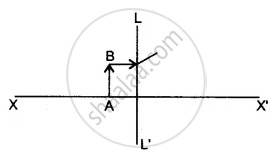Advertisements
Advertisements
प्रश्न
Complete the diagram to show the formation of the image of the object AB.

(i) Name the Lens LL’.
(ii) Where is the image of the object AB formed?
(iii) State three characteristics of the image.
उत्तर
(i) The lens is a diverging (or concave) lens.
(ii) The image of the objects is A’B’ which is formed between the optical centre and focus of the lens, in front of it.
(iii) The image is (a) virtual, (b) upright, and (c) diminished.

APPEARS IN
संबंधित प्रश्न
Calculate the focal length of a corrective lens having power +2.5 D.
Fill in the following blank with suitable word:
For converging lenses, the power is __________ while for diverging lenses, the power is ___________.
What is the unit of power of a lens? Define the unit of power of a lens.
A converging lens has a focal length of 50 cm. The power of this lens is:
A diverging lens has a focal length of 0.10 m. The power of this lens will be:
Find the radius of curvature of the convex surface of a plano-convex lens, whose focal length is 0.3 m and the refractive index of the material of the lens is 1.5.
The focal length of a concave lens is 20 cm. The focal length of a convex lens is 25 cm. These two are placed in contact with each other. What is the power of the combination? Is it diverging, converging or undeviating in nature?
An object is placed in front of a converging lens. Obtain the conditions under which the magnification produced by the lens is
- negative and
- positive.
When monochromatic red light is used instead of blue light in a convex lens, its focal length will ______.
The lens of power + 1·0 D is ______.
